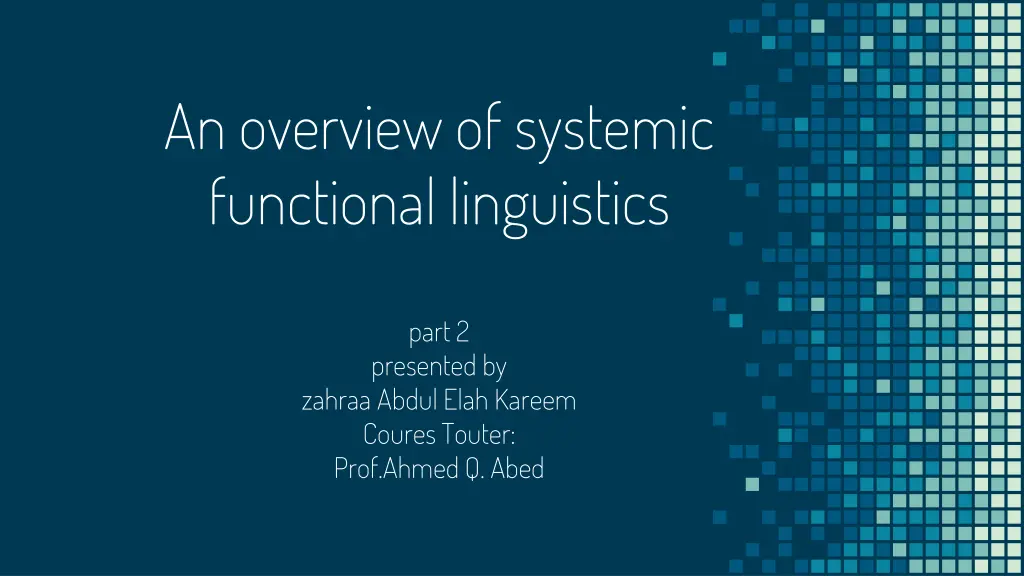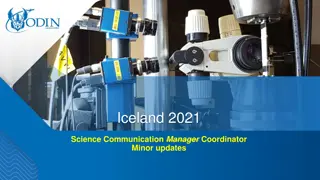
Understanding Systemic Functional Linguistics Part 2 by Zahraa Abdul ElahKareem
Explore how language is structured for use and the different types of meanings expressed through text according to Systemic Functional Linguistics, presented in an insightful course module by Zahraa Abdul ElahKareem. Dive into the intricate layers of language use and meaning-making in various contexts.
Download Presentation

Please find below an Image/Link to download the presentation.
The content on the website is provided AS IS for your information and personal use only. It may not be sold, licensed, or shared on other websites without obtaining consent from the author. If you encounter any issues during the download, it is possible that the publisher has removed the file from their server.
You are allowed to download the files provided on this website for personal or commercial use, subject to the condition that they are used lawfully. All files are the property of their respective owners.
The content on the website is provided AS IS for your information and personal use only. It may not be sold, licensed, or shared on other websites without obtaining consent from the author.
E N D
Presentation Transcript
An overview of systemic functional linguistics part 2 presented by zahraa Abdul ElahKareem CouresTouter: Prof.AhmedQ. Abed
How is Language Structured for Use? language users do not interact in order to exchange sounds with each other, nor even to exchange words or sentences. People interact in order to make meanings: to make sense of the world and of each other. The overall purpose of language, then, can be described as a semantic one, and each text we participate in is a record of the meanings that have been made in a particular context.
Crying Baby Interpersonal meaning Textual meaning Ideational meaning The writer clearly wants to establish friendly rapport with the reader, to be seen more as a 'fellow sufferer' offering useful advice based experience as career of babies. Textual meaning refers to the way the text is organized as a piece of writing or speech. The baby(he)+the parents(you) The use of language to inform There is a reason for his crying and we have to do something to stop his crying on a her lover lived and 3
This example demonstrates that a text can be seen to be expressing more than one meaning at a time. Halliday's claim that a text can make these different meanings sentences, clauses, etc.) are simultaneously making three kinds of meanings. because units of language (texts, These three types of meaning are expressed through language because these are the strands of meaning we need to make in order to make sense of each other and the world.
I suggest we attack the reds Ideational meaning Interpersonal meaning Textual meaning A suggestion, non-coercive, open to negotiation; meaning we might make with friends, whose opinions we are interested in behavior we do not seek to dominate. meaning of friendly Takes as its point of departure the speaker's intention (only to suggest, not to impose) and the interactants (we). It is a possible answer should we do now? This sentence makes meanings about bottles of wine and what we should do with them. It makes meanings that focus on the actions we, as human agents, should carry out, and the entities our actions will affect (the reds). the kind of and whose to What 5
Meaning as Choice: Semantic systems It consists of a finite set of choices or oppositions: This contains only three choices since the traffic system lights can only be either red or green or amber; The choices in the system are discrete: when you drive up to the intersection, the lights can only be one color at a time; It is the oppositions, not the substances, In the system that are important :it does not matter green or amber we use (deep red/light red, light green/dark green). All that matters is that red is not green - that each of the three colored lights is different from the others. exactly what shades of red or 6
The traffic light system illustrates the fact that semiotic systems are established by social convention. De Saussure pointed out, the fusion between the two sides of the sign is arbitrary. There is no natural link between the content STOP and the expression RED LIGHT in a traffic light system. Semiotic systems, then, are arbitrary social conventions. A semiotic system can be defined as a collection of discrete signs finite. We have a sign when a meaning (content) is arbitrarily realized through a realization (expression). 8
The traffic light system can also help to explain the function of semiotic systems. Sign systems create meanings by ordering the world in two ways: 1. They order content: of all the possible behaviors that we could enact at intersections, the system sets up only three as being meaningful (i.e. going, stopping, slowing down); 2. They lights we could have at intersections, the system sets up only three as being meaningful (i.e. red, green, amber). order expression: of all the possible colored 9
Language as a Semiotic System What gives language its privileged status is that other semiotic systems translated into language. can generally be While we can use language to talk about the semiotic systems of clothing or cars, we cannot use clothing or cars to make all the meanings language makes. language can be described as a semiotic system because it involves sets of meaningful choices or oppositions.
Considering the example: When I got home from work yesterday, I could not believe what my {progeny} had done. kid, child, brat, darling, son, boy, infant, offspring, . 12
we can describe the lexical items in a language (the vocabulary) as semiotic systems. Identifying systems of lexical choice involves recognizing that words encode meaningful oppositions, and that the process of choosing a lexical item is a semiotic process. 13
The relationship between a human infant of unspecified sex and the sound sequence k-i-d is an arbitrary one. There is a critical difference between language as a semiotic system and a simple semiotic system such as the traffic lights. For with out lexical system we can break down our lexical items into component sounds. Thus, the word kid is itself realized by a combination of the sounds k-i-d. Note that with the traffic lights we could not break down the colored lights into any smaller components. The colored lights directly realized the contents of our sign system. 14
In language, we do not just have meanings realized by words, for the words themselves are realized by sounds. This means that to describe language we need three levels or strata. 15
The Function of Language as a Semiotic System Linguistic systems make meanings by ordering the world for us in two ways: Firstly, they order content. The second way in which linguistic signs order the world for us is by ordering expression. 16
Grammatical systems in language Systems of lexical choice are not the only kind of systems we find in language. We also have systems of grammatical choice. This system says that whenever I produce a clause it must be only one of these three: a declarative: The baby is crying. an interrogative: Is the baby crying? an imperative: Cry!
The choice from a grammatical system is expressed through the presence and grammatical elements. And of course these structures will eventually get realized as words, and then finally as sounds. ordering of particular 18
Halliday points out, grammatical description is essential to text analysis: It is sometimes assumed analysis, or 'text linguistics') can be carried on without grammar - or even that it is somehow an alternative to grammar. But, this is an illusion. A discourse analysis that grammar is not an analysis at all, but simply a running commentary on a text. (Halliday 1994: xvi) that (discourse is not based on 19
In a functional-semantic approach, we are concerned to describe two dimensions of language use: Firstly, what are the possible choices people can make? In doing this we describe the linguistic system. Secondly, what is the function of the choice they did make? In doing this we describe how language is used in different social contexts, to achieve various cultural goals.
Thank you 21






















